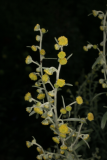Additional notes (click to expand)
Commemorative
Artemisia: after the Greek goddess Artemis who so benefitted from a plant of this family that she gave it her own name. This was also the old Latin name given to the mugwort or wormwoods. An alternative possibility for the derivation of this name is that it comes from Queen Artemisia of Halicarnassus in Asia Minor (Turkey), sister and wife of King Mausolus, who ruled after his death from 352 to 350 B.C.E. and built during her short reign one of the Seven Wonders of the Ancient World, the Mausoleum at Halicarnassus, which she unfortunately did not live to see the completion of. This is one of the many genera which Swedish botanist Carl Linnaeus published in his Species Plantarum in 1753 and is in the family Asteraceae
http://www.calflora.net/southafrica/1A-B.html
Medicinal
Culpeper: ‘... help weakness of the stomach, clense Choller, kill worms, open Stoppings, help surfets, cleer the sight, resist poisons, clense the blood and secure cloaths from moths.’
Culpeper, Nicholas. (1650). A Physical Directory . London, Peter Cole.
Notes: Used in the manufacture of the liqueur, absinthe, but it is said to be toxic – causing brain damage - and its use has been banned in many countries. Whether the hallucinations and brain damage of heavy absinthe drinkers are any different from those of all other alcoholics is still contested. The oil was used as a moth and insect repellent. It contains santonin, previously used as a vermifuge before less toxic treatments were known. It has been used as an abortifacient and a contraceptive, but its main use in Roman times – and in present day Pompei – is for colitis.
Oakeley, Dr. H. F. . (2013). The Gardens of the Pharmacopoeia Londinensis.
link
Nomenclature
– Common absinthe, Old Man, Lad’s Love, Wormwood
Oakeley, Dr. H. F. . (2013). The Gardens of the Pharmacopoeia Londinensis.
link
Other use
Ingredient of absinthe, favoured by C19th artists incl. Vincent van Gogh
Wink, Michael & Ben-Erik van Wyk (2008). Mind-Altering and Poisonous Plants of the World. Timber Press
Toxicity
Contains thujone, which means the plant is toxic if ingested in large amounts.
Professor Anthony Dayan, 2021
Geographical distribution
- Africa, Northern Africa, Algeria
- Africa, Northern Africa, Morocco
- Asia-Temperate, Middle Asia, Kazakhstan
- Asia-Temperate, Middle Asia, Kyrgyzstan
- Asia-Temperate, Middle Asia, Tadzhikistan
- Asia-Temperate, Middle Asia, Turkmenistan
- Asia-Temperate, Siberia
- Asia-Temperate, Western Asia, Afghanistan
- Asia-Temperate, Western Asia, Iran
- Asia-Temperate, Western Asia, Turkey
- Asia-Tropical, Indian Subcontinent, India
- Europe, Eastern Europe, Baltic States
- Europe, Eastern Europe, Baltic States
- Europe, Eastern Europe, Baltic States
- Europe, Eastern Europe, Belarus
- Europe, Eastern Europe, Central European Russia
- Europe, Eastern Europe, East European Russia
- Europe, Eastern Europe, Ukraine
- Europe, Middle Europe, Austria
- Europe, Middle Europe, Belgium
- Europe, Middle Europe, Germany
- Europe, Middle Europe, Netherlands
- Europe, Middle Europe, Poland
- Europe, Middle Europe, Switzerland
- Europe, Northern Europe, Denmark
- Europe, Northern Europe, Finland
- Europe, Northern Europe, Great Britain
- Europe, Northern Europe, Ireland
- Europe, Northern Europe, Norway
- Europe, Northern Europe, Sweden
- Europe, Southeastern Europe, Albania
- Europe, Southeastern Europe, Bulgaria
- Europe, Southeastern Europe, Greece
- Europe, Southeastern Europe, Italy
- Europe, Southeastern Europe, Yugoslavia
- Europe, Southwestern Europe, France
- Europe, Southwestern Europe, Portugal
- Europe, Southwestern Europe, Spain
- Northern America, Southeastern U.S.A., Georgia
Artemisia absinthium L.
Family: ASTERACEAEGenus: Artemisia
Species: absinthium L.
Common names: Wormwood
Pharmacopoeia Londinensis name: Absinthium vulgare
Distribution summary: Europe, N.Africa, Asia
Habit: Shrub
Hardiness: H5 - Hardy; cold winter
Habitat: Scrub and waste land
Garden status: Currently grown
Garden location: Europe & Mediterranean (E)
Flowering months: July, August, September
Reason for growing: Medicinal
 (15).jpg)
